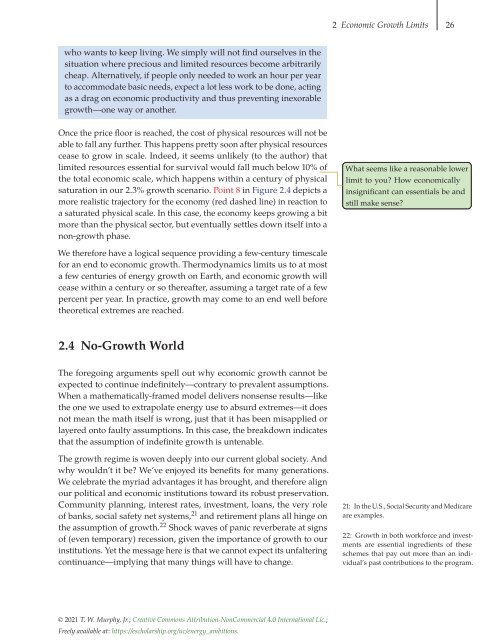Energy and Human Ambitions on a Finite Planet, 2021a
Energy and Human Ambitions on a Finite Planet, 2021a
Energy and Human Ambitions on a Finite Planet, 2021a
Create successful ePaper yourself
Turn your PDF publications into a flip-book with our unique Google optimized e-Paper software.
2 Ec<strong>on</strong>omic Growth Limits 26<br />
who wants to keep living. We simply will not find ourselves in the<br />
situati<strong>on</strong> where precious <str<strong>on</strong>g>and</str<strong>on</strong>g> limited resources become arbitrarily<br />
cheap. Alternatively, if people <strong>on</strong>ly needed to work an hour per year<br />
to accommodate basic needs, expect a lot less work to be d<strong>on</strong>e, acting<br />
as a drag <strong>on</strong> ec<strong>on</strong>omic productivity <str<strong>on</strong>g>and</str<strong>on</strong>g> thus preventing inexorable<br />
growth—<strong>on</strong>e way or another.<br />
Once the price floor is reached, the cost of physical resources will not be<br />
able to fall any further. This happens pretty so<strong>on</strong> after physical resources<br />
cease to grow in scale. Indeed, it seems unlikely (to the author) that<br />
limited resources essential for survival would fall much below 10% of<br />
the total ec<strong>on</strong>omic scale, which happens within a century of physical<br />
saturati<strong>on</strong> in our 2.3% growth scenario. Point 8 in Figure 2.4 depicts a<br />
more realistic trajectory for the ec<strong>on</strong>omy (red dashed line) in reacti<strong>on</strong> to<br />
a saturated physical scale. In this case, the ec<strong>on</strong>omy keeps growing a bit<br />
more than the physical sector, but eventually settles down itself into a<br />
n<strong>on</strong>-growth phase.<br />
What seems like a reas<strong>on</strong>able lower<br />
limit to you? How ec<strong>on</strong>omically<br />
insignificant can essentials be <str<strong>on</strong>g>and</str<strong>on</strong>g><br />
still make sense?<br />
We therefore have a logical sequence providing a few-century timescale<br />
for an end to ec<strong>on</strong>omic growth. Thermodynamics limits us to at most<br />
a few centuries of energy growth <strong>on</strong> Earth, <str<strong>on</strong>g>and</str<strong>on</strong>g> ec<strong>on</strong>omic growth will<br />
cease within a century or so thereafter, assuming a target rate of a few<br />
percent per year. In practice, growth may come to an end well before<br />
theoretical extremes are reached.<br />
2.4 No-Growth World<br />
The foregoing arguments spell out why ec<strong>on</strong>omic growth cannot be<br />
expected to c<strong>on</strong>tinue indefinitely—c<strong>on</strong>trary to prevalent assumpti<strong>on</strong>s.<br />
When a mathematically-framed model delivers n<strong>on</strong>sense results—like<br />
the <strong>on</strong>e we used to extrapolate energy use to absurd extremes—it does<br />
not mean the math itself is wr<strong>on</strong>g, just that it has been misapplied or<br />
layered <strong>on</strong>to faulty assumpti<strong>on</strong>s. In this case, the breakdown indicates<br />
that the assumpti<strong>on</strong> of indefinite growth is untenable.<br />
The growth regime is woven deeply into our current global society. And<br />
why wouldn’t it be? We’ve enjoyed its benefits for many generati<strong>on</strong>s.<br />
We celebrate the myriad advantages it has brought, <str<strong>on</strong>g>and</str<strong>on</strong>g> therefore align<br />
our political <str<strong>on</strong>g>and</str<strong>on</strong>g> ec<strong>on</strong>omic instituti<strong>on</strong>s toward its robust preservati<strong>on</strong>.<br />
Community planning, interest rates, investment, loans, the very role<br />
of banks, social safety net systems, 21 <str<strong>on</strong>g>and</str<strong>on</strong>g> retirement plans all hinge <strong>on</strong><br />
the assumpti<strong>on</strong> of growth. 22 Shock waves of panic reverberate at signs<br />
of (even temporary) recessi<strong>on</strong>, given the importance of growth to our<br />
instituti<strong>on</strong>s. Yet the message here is that we cannot expect its unfaltering<br />
c<strong>on</strong>tinuance—implying that many things will have to change.<br />
21: In the U.S., Social Security <str<strong>on</strong>g>and</str<strong>on</strong>g> Medicare<br />
are examples.<br />
22: Growth in both workforce <str<strong>on</strong>g>and</str<strong>on</strong>g> investments<br />
are essential ingredients of these<br />
schemes that pay out more than an individual’s<br />
past c<strong>on</strong>tributi<strong>on</strong>s to the program.<br />
© 2021 T. W. Murphy, Jr.; Creative Comm<strong>on</strong>s Attributi<strong>on</strong>-N<strong>on</strong>Commercial 4.0 Internati<strong>on</strong>al Lic.;<br />
Freely available at: https://escholarship.org/uc/energy_ambiti<strong>on</strong>s.


















